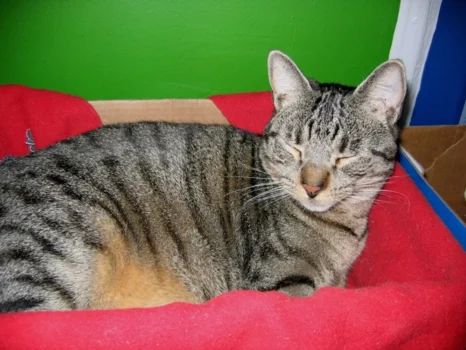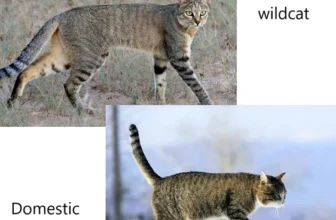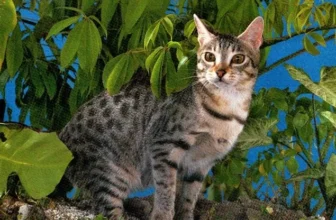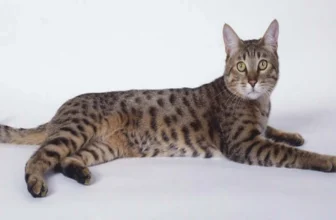Imagine a cat with a coat as unique as their personality. A coat that boasts a blend of stripes, spots, and shadow striping – a coat like no other feline. Meet the California Spangled cat, a breed that has become famous for its striking appearance. But have you ever wondered how this breed came to have its signature look? Breeding techniques have been used to create this one-of-a-kind coat, and in this article, we’ll dive into the history of the California Spangled cat, the breeding techniques used to create their distinctive look, and the future of this beautiful breed. Let’s uncover the secrets behind the California Spangled cat’s unique coat pattern.
History of the California Spangled Cat

The story of the California Spangled Cat is a fascinating one that spans over several decades. This breed of cat came into existence through a combination of various breeding techniques and genetic traits. However, despite gaining popularity quickly, they quickly became an endangered species, but thanks to the efforts of dedicated breeders like Paul Casey, they managed to make a comeback. Let’s delve deeper into the history of this majestic feline species, discuss its origins, revival, and breeding techniques that were employed to create its unique coat pattern.
Their Origins
The California Spangled cat is a unique breed that was created through the efforts of Paul Casey, an American science fiction writer and cat breeder, in the 1980s. Through a selective breeding process, Casey aimed to develop a breed of cat that resembled the wild cats of Africa and South America, such as the leopard and ocelot, while still maintaining the traits of domesticated cats.
| Fact | Description |
|---|---|
| Breed Originator | Paul Casey |
| Origin Country | United States |
| Breed Creation Year | 1980s |
| Motivation | To create a breed that resembled the wild cats of Africa and South America, while maintaining domesticated traits |
Paul Casey utilized a number of breeds including the American Shorthair, the British Shorthair, the spotted Egyptian Mau, the Abyssinian, and the Siamese in creating this breed. The result was a distinctive breed with a wild look but a friendly temperament that was well-suited to life as a domestic pet. Despite being a relatively recent breed, the California Spangled was a popular choice for cat lovers, and it quickly gained popularity in the United States and abroad.
The unique appearance of the California Spangled cat is due to the specific genetic traits that Casey selected and bred for. The traits include a distinctive spotted coat pattern, a tabby M-shape on the forehead, and shadow striping on the hind legs. These distinctive traits have made the California Spangled one of the most recognizable breeds of cat in the world.
Despite the fact that the breed enjoyed significant popularity in the 1980s and 1990s, the California Spangled cat was eventually declared extinct, due in large part to high breeding costs and a lack of interest from breeders and cat enthusiasts. Fortunately, a few dedicated breeders remained committed to preserving the breed, and through a combination of careful breeding and renewed interest from cat lovers, the California Spangled has made a comeback in recent years.
Today, the California Spangled cat is still a rare and unique breed, but it is slowly regaining popularity and recognition worldwide. With continued preservation efforts and ongoing research into breeding techniques and genetic traits, the future of this distinctive breed looks bright.
How They Became Endangered
During the 1980s, the California Spangled cat was classified as an endangered species due to several factors. One of the primary reasons for their decline was the lack of public awareness about the breed and the absence of support from prominent cat clubs.
Another factor that contributed to their diminished population was the high cost of breeding, which made it difficult for breeders to take sufficient care of the cats. As a result, many of the individuals were malnourished or suffering from health problems, affecting their overall wellness and breeding ability.
The high demand for exotic fur coats in the fashion industry led to an increase in the hunting of wild cats for their pelts. Despite its domestic origins, the California Spangled was frequently targeted for its unique coat pattern, particularly in countries where regulations regarding animal cruelty were lax.
In 1985 and 1986, two significant events took place that contributed to the revival of the California Spangled breed. Firstly, the release of the movie ‘Cat’s Eye’ brought widespread attention to the breed’s beauty and rarity. Secondly, Paul Casey, who originally bred the California Spangled, made a public appearance on a chat show to discuss the breed’s plight. These events led to renewed interest in the breed and a resurgence of small-scale breeding operations.
Thus, the California Spangled breed was not inherently endangered by natural selection or inability to adapt to its environment. Instead, it was humans who endangered the breed due to their immediate desires and lack of foresight. The California Spangled decline was a warning for the impact of humans on nature, especially endangered species. Fortunately, the successful revival of this breed provides an example of how cooperative action can help protect and preserve endangered species.
To know more about California Spangled Origins, click here.
Their Return
The California Spangled Cat was declared an official cat breed by Paul Casey in 1986 after years of careful and deliberate breeding efforts. After their initial introduction to the public, these cats quickly gained popularity and were featured in various movies, advertisements, and television shows. Unfortunately, the initial excitement surrounding the breed was short-lived, and they faced a significant decline in popularity.
Their Return: In recent years, there has been a renewed interest in the California Spangled Cat breed, and many breeders are dedicated to preserving the unique characteristics of these beautiful creatures. The revival of interest in this breed is due to their strong genetic traits and strikingly beautiful coat patterns. As a result, many breeders are taking steps to increase the population and make the California Spangled Cat more readily available.
To further preserve the breed, the Spangled Cat Society was established in 1999 with the goal of promoting the welfare of the California Spangled Cat and educating others on the importance of preserving the breed. The society has accomplished this by promoting responsible breeding practices that focus on maintaining the breed’s genetic diversity and avoiding inbreeding.
It is truly heartening to see the California Spangled Cat make a comeback. Consistent efforts by breeders, organizations such as the Spangled Cat Society, and increased awareness among cat enthusiasts are critical in ensuring the long-term survival and continued success of this unique and fascinating breed. To learn more about the California Spangled Cat’s history, check out this insightful article: California Spangled Cat: Decline and Revival.
Breeding Techniques

When it comes to developing a unique and highly distinctive breed like the California Spangled, there are some rather remarkable breeding techniques involved. These methods have been refined over time and involve careful considerations about genetics and traits of the California Spangled cat. Selective breeding, crossbreeding, and introducing new genes have all played an important role in shaping the breed. Let’s take a closer look at the techniques that have been used to create such a fascinating feline.
Selective Breeding
Selective breeding is a technique used by breeders to produce cats with specific physical and personality traits. Breeders carefully select parent cats with desirable traits to mate and produce the next generation of kittens. This technique has been used extensively in the creation of the California Spangled cat breed.
California Spangled Breeder Paul Casey is considered one of the pioneers in the breed’s development. He used selective breeding to produce cats with the unique spotted coat pattern, strong and athletic builds, and friendly personalities. He aimed to produce a breed of cat that resembled the wild leopard but with a loving and affectionate disposition suitable for a domestic setting.
Casey selected cats with desirable physical traits, such as a powerful musculature, and a broad, short head. These cats had mottled markings on their coats, which formed the foundation of the California Spangled cat’s unique coat pattern.
To create a well-balanced and friendly temperament, Casey also selectively bred cats with pleasant personalities. These cats enjoyed human companionship, were affectionate, and had a tolerant disposition towards other animals.
Selective breeding enabled Casey to improve the physical traits and personality of the cats he produced, creating a unique and popular breed.
| Technique | Advantages | Disadvantages |
|---|---|---|
| Selective Breeding | Produces cats with desirable physical and personality traits | May lead to inbreeding which can result in genetic diseases |
| Crossbreeding | Allows breeders to introduce new physical traits and genetic diversity | May produce offspring with undesirable traits |
| Introducing New Genes | Allows breeders to introduce specific genetic traits without crossbreeding | May not always result in the desired traits |
To read more about Paul Casey and the California Spangled breed click here, or click here for more information on the genetic traits of the California Spangled breed.
Crossbreeding
Crossbreeding is another technique used to develop the unique coat pattern of the California Spangled Cat. This involves breeding two different breeds of cats to produce offspring with desirable traits. In the case of the California Spangled Cat, several types of breeds were used in the initial development, including Persian, Siamese, British Shorthair, American Shorthair, Abyssinian, and Egyptian Mau.
The goal of crossbreeding was to produce a cat with a wild appearance, similar to that of a leopard, while maintaining a domestic temperament. Crossbreeding also allowed breeders to introduce new colorations and patterns into the breed.
Here is a table of the breeds used in crossbreeding for the development of the California Spangled Cat:
| Breed | Characteristic |
|---|---|
| Persian | Affectionate nature and long-haired coat |
| Siamese | Distinct coloring and sleek body type |
| British Shorthair | Thick coat and round face |
| American Shorthair | Robust body and strong hunting instincts |
| Abyssinian | Energetic personality and distinctive ticked coat |
| Egyptian Mau | Spotted coat and athletic build |
Through selective crossbreeding, breeders were able to produce cats with desirable traits, such as a unique coat pattern and a domesticated temperament. The California Spangled Cat is a beautiful and rare breed of cat that has captivated cat lovers around the world and is a testament to the power of selective breeding.
Introducing New Genes
In addition to selective breeding and crossbreeding, another technique used to create the unique coat pattern of California Spangled cats is introducing new genes. This can be a tricky process as it involves finding the right balance between preserving the desirable traits of the breed while also introducing new genetic material to improve it.
Here are some ways in which new genes have been introduced to California Spangled cats:
- Outcrossing: This involves breeding a California Spangled cat with a different breed that has certain desirable traits. The offspring of the crossbreed may then be bred back to purebred California Spangled cats, which helps to dilute any undesirable traits that may have been introduced while still retaining the new desirable traits.
- Cryopreservation: This involves preserving embryos or sperm from a desirable cat for future use. These preserved materials can be used to introduce new genes without the need to bring in a new cat.
- Genetic Engineering: This involves altering the DNA of a California Spangled cat to introduce new genes. While this technique is still in its early stages, it has the potential to dramatically change the future of cat breeding.
However, it’s important to note that introducing new genes can also come with risks. Inbreeding and genetic defects are a concern when breeding any type of animal, so caution must be taken when introducing new genetic material. It’s up to cat breeders to find the right balance between preserving the breed and improving it through introducing new genes.
The Unique Coat Pattern
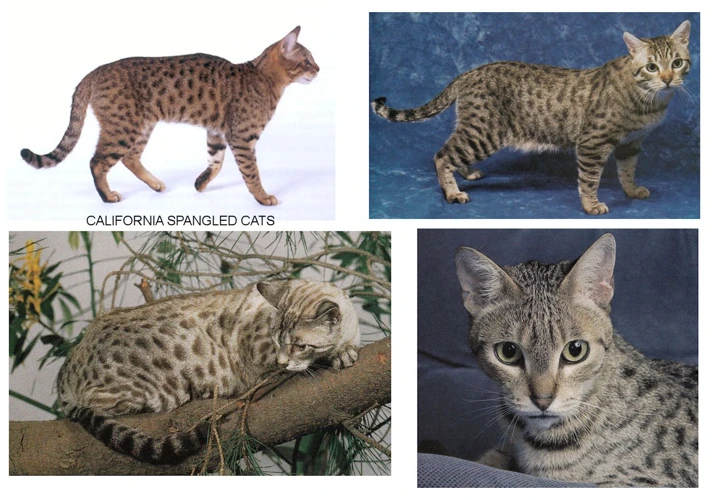
California Spangled Cats are known for their unique coat patterns, which are a result of carefully planned breeding techniques. The combination of spots, tabby M-shape on the forehead, and shadow striping on the hind legs make them one of the most visually stunning cat breeds in existence. However, how did breeders achieve these unique patterns? In this section, we explore the breeding techniques used to create the remarkable coat pattern that adorns the California Spangled Cat, from selective breeding to introducing new genes.
The Spotted Coat
The spotted coat of the California Spangled cat is one of its most unique and defining features. It is achieved through selective breeding techniques that carefully select cats with distinctive spots and patterns. The spots are typically black or dark brown, but can also be shades of gold or copper.
Breeding for the spotted coat pattern involves pairing cats with desirable spotting characteristics and mating them to produce offspring that showcase those traits. Breeders look for traits such as the size, shape, and placement of the spots, as well as the overall distribution of spots across the cat’s body.
Some interesting facts about the California Spangled’s spotted coat:
- The spots on a California Spangled cat are not random. Each cat’s spots are unique and individual, just like a human fingerprint.
- The size and shape of the spots can vary greatly, even within a single litter of kittens.
- The spotted coat is often described as “wild” or “jungle-like,” giving the cat a fierce and untamed appearance.
- In addition to the spots, the California Spangled cat has other distinctive physical characteristics, including large, expressive ears and an athletic, muscular build.
Given their striking appearance and unique coat pattern, it is no wonder that the California Spangled cat has become a highly sought-after breed for cat lovers around the world. However, as with any selectively bred animal, it is important to ensure that breeding practices are ethical and responsible, and that the welfare of the cats is always a top priority.
The Tabby M-Shape on the Forehead
A distinguishing feature of the California Spangled cat is the tabby M-shape on their forehead. This unique marking is a result of the careful breeding techniques used to develop their appearance.
One technique utilized by breeders to ensure this marking is called tabby patterning. This involves selectively breeding cats with the distinctive “M” shape marking on their forehead, such as the Abyssinian, Bengal, and Egyptian Mau breeds. These cats were chosen for their genetic makeup and their ability to pass on the tabby M-shape trait to their offspring.
It is believed that this marking serves as a way to distinguish the California Spangled cat from other breeds, as well as provide camouflage in their natural habitat. This marking is also believed to be a sign of a strong immune system and overall good health, making it an attractive trait for potential cat owners.
The M-shape on the forehead of the California Spangled cat is usually bold and defined, standing out against the rest of their coat. It is typically a black or dark brown color, creating a striking contrast against lighter colored fur. This feature is highly sought after by cat enthusiasts and breeders alike, making it an important aspect of the California Spangled’s unique appearance.
The tabby M-shape on the forehead of the California Spangled cat is a testament to the careful breeding techniques used to develop this distinctive breed. It is a unique feature that sets them apart from other breeds and serves as a marker of good health and strong genetics.
The Shadow Striping on the Hind Legs
The shadow striping on the hind legs is one of the unique coat patterns that sets the California Spangled cat apart from other breeds. This pattern features thin, dark stripes that appear on the lower portion of the hind legs. The stripes are reminiscent of a shadow and give the cat a distinct look that is both elegant and playful.
The shadow striping pattern is the result of a complex genetic combination that breeders carefully select for. This pattern is not always present in every cat, and it can vary in intensity and location. Some California Spangled cats may have more pronounced striping, while others may have lighter or more subtle patterns.
To better understand the shadow striping pattern, let’s take a closer look at the genetics behind it. This pattern is caused by a specific gene, known as the tabby gene. This gene controls the production of the pigment that creates the stripes on a cat’s coat.
In California Spangled cats, breeders select for cats that have a dominant tabby gene. This gene is responsible for producing the shadow stripe pattern on the hind legs. When two cats with dominant tabby genes are bred together, their offspring will also have a dominant tabby gene and are likely to inherit the shadow stripe pattern.
Interestingly, the shadow stripe pattern is not exclusive to the California Spangled cat. Other cat breeds, such as the Bengal and the Egyptian Mau, also exhibit this unique coat pattern. However, the shadow stripe pattern is particularly prominent in the California Spangled breed and has become one of its defining features.
The shadow striping on the hind legs is a subtle yet striking coat pattern that is unique to the California Spangled cat. It is caused by a specific gene and is carefully selected for by breeders to preserve the breed’s distinctive look. This pattern, along with the other coat patterns, underscores the beauty and uniqueness of the California Spangled breed.
| Characteristics | Details |
|---|---|
| Appearance | The shadow striping pattern features thin, dark stripes that appear on the lower portion of the hind legs. |
| Genetics | The pattern is caused by the tabby gene, which produces the pigment that creates the stripes. |
| Breeding | Breeders select for cats with dominant tabby genes to produce offspring with the shadow stripe pattern. |
| Uniqueness | The shadow stripe pattern is present in other cat breeds, but it is particularly prominent and defining in the California Spangled breed. |
The Future of the California Spangled Cat
It’s natural to wonder about the future of the beautiful and unique California Spangled Cat. With their tumultuous history and the challenges they faced to survive, many people are curious about what the future holds for them. Fortunately, efforts are being made to preserve and protect this precious breed. In this section, we’ll take a closer look at what’s being done to ensure the survival of the California Spangled Cat. We’ll explore the different methods being employed to keep the breed alive and thriving, and discuss the importance of continued research into breeding techniques. Let’s dive in and see what the future may hold for this remarkable feline.
Preserving the Breed
To ensure the longevity of the California Spangled Cat, preserving the breed is of utmost importance. This entails carefully selecting individuals for breeding and preventing inbreeding. The use of strong pedigree analysis has become necessary to ensure that the desired traits are maintained while reducing health problems.
Another way to preserve the breed is through embryo transfer. This technique involves transferring embryos from a genetically superior donor to a recipient female. This helps to propagate the superior genetics of the donor cat while allowing the recipient female to carry and give birth to the kittens.
To further promote the breed, organizations such as The International Cat Association have established breed standards for judges and breeders to follow. The establishment of breed standards ensures that the physical characteristics and temperament of the California Spangled Cat are consistently maintained.
Promoting responsible pet ownership by educating potential owners on the unique needs of the California Spangled Cat can help to ensure the breed’s survival. This includes providing them with a suitable environment, exercise, and a proper diet.
Lastly, continued research into breeding techniques and the genetics of the breed is essential for the preservation of the California Spangled Cat. With new technologies such as gene editing and gene mapping, the possibilities for improving the breed are endless.
Preserving the California Spangled Cat breed requires a combination of careful breeding, education, and ongoing research. However, with the dedication of breeders and cat enthusiasts, this unique and beautiful breed can thrive for many years to come.
| Preservation Techniques | Benefits |
| Pedigree Analysis | Ensures desired traits are maintained while reducing health problems |
| Embryo Transfer | Maintains superior genetics of donor while allowing recipient to give birth |
| Breed Standards | Ensures consistency of physical characteristics and temperament |
| Education | Promotes responsible pet ownership to ensure their unique needs are met |
| Research | Allows for the development of new technologies and techniques to improve the breed |
Continued Research on Breeding Techniques
The California Spangled Cat has a unique coat pattern that sets it apart from other cat breeds, and this is a result of the specific breeding techniques used to create the breed. However, there is still much research that needs to be done in order to better understand the genetics behind this coat pattern and to continue improving breeding techniques.
1. Understanding Genetics: One area of continued research is in understanding the genetics of the California Spangled Cat’s coat pattern. Scientists are currently studying the specific genes that are responsible for the unique coat pattern. This will allow for further refinement of breeding techniques and confirm the best methods for achieving desirable patterns.
2. Improving Selective Breeding: While selective breeding has been used to create the California Spangled Cat breed, there is still room for improvement. Continued research can help identify genetic mutations that can lead to better results and new coat patterns. Breeders can then use this information to selectively breed cats that are more likely to produce desired coat patterns.
3. Crossbreeding: Crossbreeding can also be used to introduce new genes and coat patterns to the California Spangled Cat breed. Continued research can help identify breeds that have similar genetic traits to California Spangled Cats, which can then be selectively crossed to create even more unique and desirable coat patterns.
4. Avoiding Inbreeding: One important area of continued research in breeding techniques is avoiding inbreeding, which can lead to genetic problems such as weakened immune systems and decreased fertility. Breeders will need to take steps to ensure that inbreeding does not occur within the California Spangled Cat breed, while still maintaining desirable coat patterns.
5. Ethical Considerations: As with any breeding program, ethical considerations should always be taken into account. Continued research will help ensure that breeding techniques are humane and the breed is healthy and well cared for.
Continued research on breeding techniques is crucial for preserving the unique and desirable coat patterns of the California Spangled Cat while ensuring the breed’s long-term health and well-being. With ongoing research, breeders can continue to refine techniques and create new and exciting coat patterns.
Conclusion
In conclusion, the California Spangled Cat is a unique breed that has faced many challenges in its history. From being on the brink of extinction to slowly making a comeback, the preservation of this breed is important. The breeding techniques used to create their distinctive coat pattern involve a combination of selective breeding, crossbreeding, and introducing new genes. These techniques have resulted in a beautiful coat pattern that features spotted markings, a tabby m-shape on the forehead, and shadow striping on the hind legs.
Moving forward, it is crucial that efforts continue to be made to preserve this breed. Continued research on breeding techniques will also be essential to ensure that the California Spangled Cat breed can thrive for many years to come. By working towards the preservation of this unique breed, we can ensure that future generations can experience the beauty and charm of the California Spangled Cat.
Overall, the California Spangled Cat is a testament to the amazing things that can be achieved through strategic breeding techniques. Through the hard work and dedication of breeders, this incredible breed has been brought back from the brink of extinction. With a bright future ahead, we can all look forward to seeing more of these stunning cats in the years to come.
Frequently Asked Questions
What makes the California Spangled Cat unique?
The California Spangled Cat is unique not only for its striking coat pattern but also for its social and intelligent nature.
What was the original purpose of breeding the California Spangled Cat?
The California Spangled Cat was originally designed to be a domesticated cat that resembled wildcats like leopards and ocelots.
How were early breeding efforts of the California Spangled Cats impacted by their endangered status?
Early breeding efforts of the California Spangled Cat were heavily impacted by the fact that the breed was on the verge of extinction, which made it difficult to find purebred individuals for breeding.
What is selective breeding?
Selective breeding is the process of choosing specific traits that are desirable and breeding individuals with those traits to produce offspring that are more likely to have them.
How does crossbreeding affect the California Spangled Cat’s unique coat pattern?
Crossbreeding can introduce new genes into the breeding pool, which can alter the coat pattern of the California Spangled Cat.
What are some of the challenges that come with introducing new genes to the California Spangled Cat’s breeding pool?
The challenges of introducing new genes to the California Spangled Cat’s breeding pool include ensuring that the new genes do not adversely affect the cat’s health or change its appearance too much.
What is the most distinctive feature of the California Spangled Cat’s coat pattern?
The most distinctive feature of the California Spangled Cat’s coat pattern is the spotted coat.
What is the significance of the tabby M-shape on the California Spangled Cat’s forehead?
The tabby M-shape on the California Spangled Cat’s forehead is a unique characteristic that sets the breed apart from other spotted cats.
What is the importance of preserving the California Spangled Cat breed?
Preserving the California Spangled Cat breed is important for maintaining genetic diversity in domesticated cats and for helping to prevent the extinction of this unique breed.
How can the public help support the preservation of the California Spangled Cat breed?
The public can help support the preservation of the California Spangled Cat breed by educating themselves on the breed, supporting breeders who prioritize the preservation of the breed, and advocating for laws that protect and preserve endangered domesticated animal breeds.

